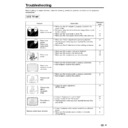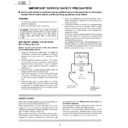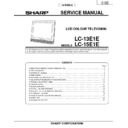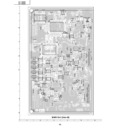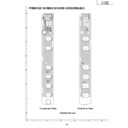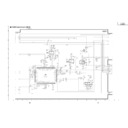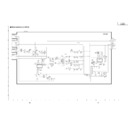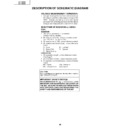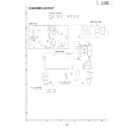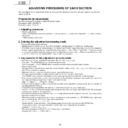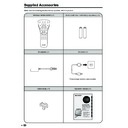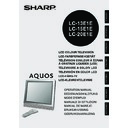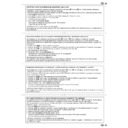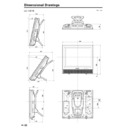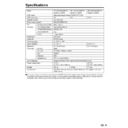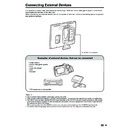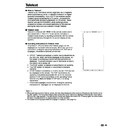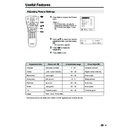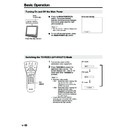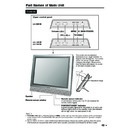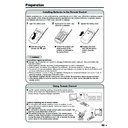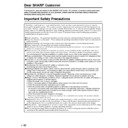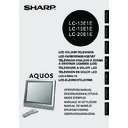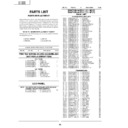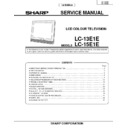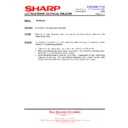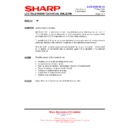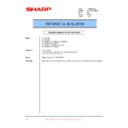Sharp LC-15E1E (serv.man21) User Manual / Operation Manual ▷ View online
48
Problem
Check item
• The reception may be weak.
• The quality of the broadcast may also be bad.
• Make sure the antenna is facing the correct direction.
• Make sure the outside antenna has not been disconnected.
• The quality of the broadcast may also be bad.
• Make sure the antenna is facing the correct direction.
• Make sure the outside antenna has not been disconnected.
• Make sure the antenna is facing the correct direction.
• Broadcast waves may be reflected from adjacent mountains or
• Broadcast waves may be reflected from adjacent mountains or
buildings.
• There may be interference from automobiles, trains, high-voltage
lines, neon lights, etc.
• There may be interference between the antenna cable and power
cable. Try positioning them further apart.
• Is the unit receiving interference from other devices?
Transmission antennas of radio broadcasting stations and
transmission antennas of amateur radios and cellular phones may
also cause interference.
transmission antennas of amateur radios and cellular phones may
also cause interference.
• Use the unit as far apart as possible from devices that may cause
possible interference.
The picture is
not sharp.
not sharp.
The picture has
ghosts.
ghosts.
There are
stripes on the
screen or
colours fade.
stripes on the
screen or
colours fade.
The picture
shakes.
shakes.
The picture is
spotted.
spotted.
Antenna
Troubleshooting (Continued)
■ Use in hot and cold rooms (locations)
• When the unit is used in rooms (locations) with low temperature, the picture may leave trails or appear
slightly delayed. This is not a malfunction, and the unit will recover when the temperature returns to normal.
• Do not leave the unit in a hot or cold location. Also, do not leave the unit in a location exposed to direct
sunlight or near a heater, as this may cause the cabinet to deform and the LCD panel to malfunction.
(Storage temperature: –20˚C to +60˚C)
(Storage temperature: –20˚C to +60˚C)
48
Problem
Check item
• The reception may be weak.
• The quality of the broadcast may also be bad.
• Make sure the antenna is facing the correct direction.
• Make sure the outside antenna has not been disconnected.
• The quality of the broadcast may also be bad.
• Make sure the antenna is facing the correct direction.
• Make sure the outside antenna has not been disconnected.
• Make sure the antenna is facing the correct direction.
• Broadcast waves may be reflected from adjacent mountains or
• Broadcast waves may be reflected from adjacent mountains or
buildings.
• There may be interference from automobiles, trains, high-voltage
lines, neon lights, etc.
• There may be interference between the antenna cable and power
cable. Try positioning them further apart.
• Is the unit receiving interference from other devices?
Transmission antennas of radio broadcasting stations and
transmission antennas of amateur radios and cellular phones may
also cause interference.
transmission antennas of amateur radios and cellular phones may
also cause interference.
• Use the unit as far apart as possible from devices that may cause
possible interference.
The picture is
not sharp.
not sharp.
The picture has
ghosts.
ghosts.
There are
stripes on the
screen or
colours fade.
stripes on the
screen or
colours fade.
The picture
shakes.
shakes.
The picture is
spotted.
spotted.
Antenna
Troubleshooting (Continued)
■ Use in hot and cold rooms (locations)
• When the unit is used in rooms (locations) with low temperature, the picture may leave trails or appear
slightly delayed. This is not a malfunction, and the unit will recover when the temperature returns to normal.
• Do not leave the unit in a hot or cold location. Also, do not leave the unit in a location exposed to direct
sunlight or near a heater, as this may cause the cabinet to deform and the LCD panel to malfunction.
(Storage temperature: –20˚C to +60˚C)
(Storage temperature: –20˚C to +60˚C)
48
Problem
Check item
• The reception may be weak.
• The quality of the broadcast may also be bad.
• Make sure the antenna is facing the correct direction.
• Make sure the outside antenna has not been disconnected.
• The quality of the broadcast may also be bad.
• Make sure the antenna is facing the correct direction.
• Make sure the outside antenna has not been disconnected.
• Make sure the antenna is facing the correct direction.
• Broadcast waves may be reflected from adjacent mountains or
• Broadcast waves may be reflected from adjacent mountains or
buildings.
• There may be interference from automobiles, trains, high-voltage
lines, neon lights, etc.
• There may be interference between the antenna cable and power
cable. Try positioning them further apart.
• Is the unit receiving interference from other devices?
Transmission antennas of radio broadcasting stations and
transmission antennas of amateur radios and cellular phones may
also cause interference.
transmission antennas of amateur radios and cellular phones may
also cause interference.
• Use the unit as far apart as possible from devices that may cause
possible interference.
The picture is
not sharp.
not sharp.
The picture has
ghosts.
ghosts.
There are
stripes on the
screen or
colours fade.
stripes on the
screen or
colours fade.
The picture
shakes.
shakes.
The picture is
spotted.
spotted.
Antenna
Troubleshooting (Continued)
■ Use in hot and cold rooms (locations)
• When the unit is used in rooms (locations) with low temperature, the picture may leave trails or appear
slightly delayed. This is not a malfunction, and the unit will recover when the temperature returns to normal.
• Do not leave the unit in a hot or cold location. Also, do not leave the unit in a location exposed to direct
sunlight or near a heater, as this may cause the cabinet to deform and the LCD panel to malfunction.
(Storage temperature: –20˚C to +60˚C)
(Storage temperature: –20˚C to +60˚C)
48
Problem
Check item
• The reception may be weak.
• The quality of the broadcast may also be bad.
• Make sure the antenna is facing the correct direction.
• Make sure the outside antenna has not been disconnected.
• The quality of the broadcast may also be bad.
• Make sure the antenna is facing the correct direction.
• Make sure the outside antenna has not been disconnected.
• Make sure the antenna is facing the correct direction.
• Broadcast waves may be reflected from adjacent mountains or
• Broadcast waves may be reflected from adjacent mountains or
buildings.
• There may be interference from automobiles, trains, high-voltage
lines, neon lights, etc.
• There may be interference between the antenna cable and power
cable. Try positioning them further apart.
• Is the unit receiving interference from other devices?
Transmission antennas of radio broadcasting stations and
transmission antennas of amateur radios and cellular phones may
also cause interference.
transmission antennas of amateur radios and cellular phones may
also cause interference.
• Use the unit as far apart as possible from devices that may cause
possible interference.
The picture is
not sharp.
not sharp.
The picture has
ghosts.
ghosts.
There are
stripes on the
screen or
colours fade.
stripes on the
screen or
colours fade.
The picture
shakes.
shakes.
The picture is
spotted.
spotted.
Antenna
Troubleshooting (Continued)
■ Use in hot and cold rooms (locations)
• When the unit is used in rooms (locations) with low temperature, the picture may leave trails or appear
slightly delayed. This is not a malfunction, and the unit will recover when the temperature returns to normal.
• Do not leave the unit in a hot or cold location. Also, do not leave the unit in a location exposed to direct
sunlight or near a heater, as this may cause the cabinet to deform and the LCD panel to malfunction.
(Storage temperature: –20˚C to +60˚C)
(Storage temperature: –20˚C to +60˚C)
Display

